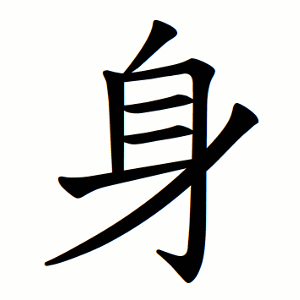身
- body;
It refers to the main part of the human body from the head down to the thighs.
Etymology
According to the Shuowen Jiezi (説文解字 shuōwén jiězì), it is explained as a phono-semantic compound character. However, looking at ancient forms such as oracle bone script, where the abdomen is shown as a protruding part of a person, its original meaning is believed to be related to pregnancy.
In classical texts like the Shijing (Book of Songs), 身 is sometimes used with the meaning of pregnancy. The compound phrase 身重 (meaning “being heavily pregnant”) also reflects this. The character 娠 (meaning “to bear a child”) shares the same pronunciation and is thought to have a common origin with 身.
Over time, the meaning of 身 expanded from referring to the main body parts to denote the entire body excluding the head and above. It came to refer not only to humans but also to animals, the main trunk or body of tools, and even oneself (the self).
Usage in Korean
When used as a radical (meaning-bearing component), it conveys meanings related to the body.
It is typically placed on the left side of a character, forming a left-right structure.
- 竹難竹 (HXH)
